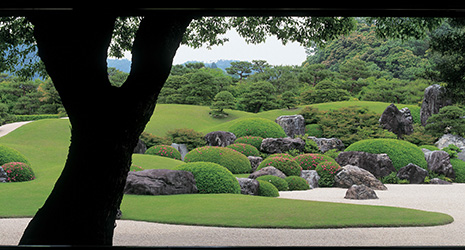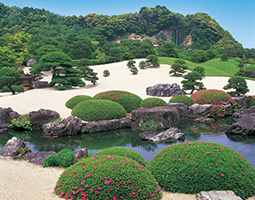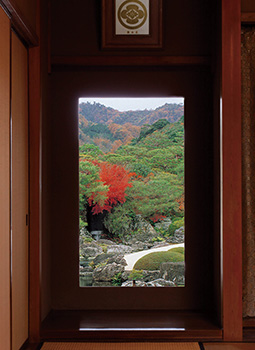INDEX
- English
- 日本語

The Living Framed Painting viewed in spring - English
- 日本語

The Living Framed Painting viewed in autumn

The White Gravel and Pine Garden: Garden scenery incorporating the Kikaku Waterfall (upper right) on Mt. Kikaku—an example of shakkei (borrowed scenery) 
The Living Hanging Scroll, in which the gardens are viewed like a painting through a cut-out in an alcove wall
May 2021
Gardens That Look Just Like Landscape Paintings


The Japanese gardens at the Adachi Museum of Art have received high praise both from within Japan and abroad for their “landscape painting-like” beauty, and hold an endless fascination for visitors.

Located in Yasugi City in Shimane Prefecture, the Adachi Museum of Art is a unique art museum based on the concept of “harmony between Japanese gardens and traditional Japanese painting.” The museum houses approximately 2,000 works in total of mainly pre- and post-World War II Japanese art, including the works of the master of Japanese painting (Nihonga) Yokoyama Taikan (1868–1958, hereinafter Taikan) and the pottery of Kitaoji Rosanjin (1883–1959). The museum also features about 165,000 square meters of gardens artistically designed on a variety of themes, including the main Dry Landscape Garden* which overlooks natural mountains, the Moss Garden, the Pond Garden, and more. These gardens have been selected as the best in Japan for eighteen consecutive years since 2003 in Sukiya Living Magazine – The Journal of Japanese Gardening, a magazine dedicated to Japanese gardens that is published in the United States.
The museum’s general manager, Takeda Wataru, who works in the public relations department, says, “Adachi Zenko (1899–1990), a local businessman, founded the Adachi Museum of Art in 1970 to exhibit the works of art he had collected over many years. He spoke about how ‘the garden is also a picture,’ and aimed to create an art museum where both art and gardens could be enjoyed, devoting himself to the creation of the gardens and collecting works of art until he passed away at 92.”
Adachi loved Taikan’s paintings in particular and acquired about 120 works from the artist’s early days to his later works, meaning the museum holds the most complete collection of Taikan’s work, both in quality and quantity. Within the museum, highlights include The Living Framed Painting, where a window frame around a large window acts as a picture frame, allowing the viewer to enjoy the gardens as art. The Kikaku Waterfall, 15 meters tall and falling over the bare mountain, is a manmade waterfall recreating the scenery found in Taikan’s famous Waterfall in Nachi. Before they know it, visitors gazing at this garden will feel as if they have been drawn into Taikan’s painting.**

According to Takeda, it is extremely rare for an art museum to have a gardens department, and every day seven specialist gardeners work to manage and maintain the gardens.
For four consecutive years from 2016 until 2019, more than 600,000 people from within Japan and around the world visited the Adachi Museum each year. The museum’s Japanese gardens have a Three-Star rating—the highest rating—in The Michelin Green Guide Japan, the long-established French travel guidebook (sixth edition).
Even today, the gardeners of the Adachi Museum of Art are busy maintaining the vast gardens in preparation for the day the spread of the coronavirus subsides and many people from within Japan and abroad can visit again.
* A dry landscape garden is a garden expressing a natural landscape using rocks and sand.
** The waterfall in Taikan’s painting is the 133-meter Nachi Falls in Wakayama Prefecture.

